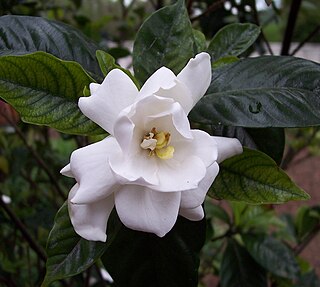
Gardenia is a genus of flowering plants in the coffee family, Rubiaceae, native to the tropical and subtropical regions of Africa, Asia, Madagascar and Pacific Islands, and Australia.
Alleizettella is a genus of flowering plants in the family Rubiaceae. It is restricted to southeastern China and northern Vietnam. The genus commemorates French botanist Aymar Charles d'Alleizette.

Canthium is a genus of flowering plants in the family Rubiaceae. They are shrubs and small trees. The leaves are deciduous and the stems are usually thorny.
Glionnetia is a monotypic genus of flowering plants in the family Rubiaceae. The genus contains only one species, viz. Glionnetia sericea, which is endemic to Mahé and Silhouette Island in the Seychelles. The species thrives mainly on high ridges in the mountains and it does not seem to grow well at lower altitudes. Glionnetia sericea is a small flower with paniculate terminal inflorescences and it has capsules that are dispersed by wind.
Prismatomeris is a genus of plant in the family Rubiaceae. It contains the following species :

Rothmannia is a genus of flowering plants in the family Rubiaceae. It was described in 1776 and is named for Göran Rothman (1739–1778) by Thunberg – both were pupils of Linnaeus.

Aidia is a genus of flowering plants in the family Rubiaceae. It was described by João de Loureiro in 1790. It has a wide distribution area and occurs in tropical Africa, tropical and subtropical Asia and the western Pacific.
Brachytome is a genus of 8 species of flowering plants in the family Rubiaceae. It was described by Joseph Dalton Hooker in 1871. It occurs in mainland Southeast Asia from Bangladesh, east to south central China and south to Peninsular Malaysia.
Dimetia is a genus of flowering plants in the family Rubiaceae. The genus is found from the Indian subcontinent to south-central China and west and central Malesia.

Catunaregam is a genus of flowering plants in the family Rubiaceae, native to tropical Africa and tropical Southeast Asia.
Rubovietnamia is a genus of plants in the family Rubiaceae, native to Vietnam and southern China.
Ceriscoides is a genus of flowering plants in the family Rubiaceae. The genus is found from the Hainan province to tropical Asia.
Diplospora is a genus of flowering plants in the family Rubiaceae. The genus is found in tropical and subtropical Asia.

Gardenieae is a tribe of flowering plants in the family Rubiaceae and contains about 586 species in 53 genera.
Greenea is a genus of flowering plants in the family Rubiaceae. The genus is found from Indo-China to Sumatra. It is named in honor of Benjamin D. Greene.
Xantonnea is a genus of flowering plants in the family Rubiaceae. The genus has only two species that are found in Cambodja, Laos, Thailand, and Vietnam.
Fosbergia is a genus of flowering plants in the family Rubiaceae. The genus is found in southern China, Thailand, and Vietnam.
Ridsdalea is an Asian genus of plants in the family Rubiaceae; it was named after Dr. Colin Ridsdale. The type species is Ridsdalea grandis(Korth.) J.T.Pereira, which was re-named from the basionym Gardenia grandis. Several other species have been re-assigned from other genera: notably Rothmannia, which is now reserved for African species. Its native range is southern China, Indo-China, Malesia and New Guinea.
Kailarsenia is a genus of flowering plants in the tribe Gardenieae of the family Rubiaceae. Its native range is Indo-China to West Malesia.

Larsenaikia is a genus of flowering plants in the tribe Gardenieae of the family Rubiaceae. Its native range is Eastern and Northern Australia.






